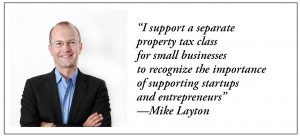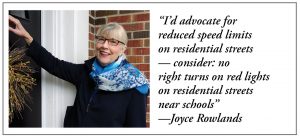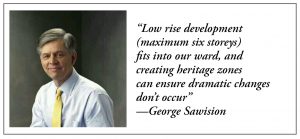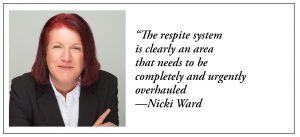See where hopefuls stand
It’s a bit ironic that municipal elections attract the lowest voter turnouts. Ironic because decisions made at City Hall have a greater impact on your day-to-day life than those made in the legislature or in parliament. On any given day, Toronto City Council will consider garbage, snow removal, transit, zoning, parks…the list is endless. Yet it can be difficult for councillor candidates to attract attention, much less your vote.
That’s why we’ve chosen to be expansive. In this municipal election guide, we put councillor candidates for the new Ward 11, University-Rosedale, to the test, asking them to answer questions developed by the residents’ associations and BIAs in our coverage area. We also asked the associations to send us questions for candidates running for trustee in the Catholic and public school boards, and their answers can be found here for the TDSB and here for the TCDSB.
We emailed the questions to all candidates, and gave them a week to respond, asking them to keep each answer to 100 words or less. We’ve published all the answers we received, editing only for length, grammar, and style. We did not get replies from Michael Borrelli or Michael Shaw.
Compiled by Ellie Hayden
What will you do to ensure that families have pedestrian-friendly spaces where kids can safely walk to school and how will you promote extra-curricular activities? —Annex Residents’ Association
Marc Cormier: I will support the doubling of playgrounds within the ward, because there is a serious lack of infrastructure for safe play areas for our children. I will also support participatory design with input from the primary users: the children.
I shall also ask that we redesign pedestrian crossovers, so they are clearly visible using a false 3D paint job. Too many accidents happen at these crossovers as they often give pedestrians a false sense of security.
Cycling in Toronto is dangerous and deadly. We need to create true bike lanes. At the same time, I support increased fines and police campaigns for cyclists who use sidewalks and don’t obey traffic laws and signals.
Mike Layton: Vision Zero offers a toolkit of options to make our public spaces pedestrian friendly. This could include re-engineering our streets to create better buffer zones between moving traffic and pedestrians with vertical barriers. I will work with residents to find local solutions to safety concerns in our neighbourhoods, and take action in areas identified by the residents and staff to correct dangerous areas.
The City of Toronto should invest more in after-school programming for children and we can utilize our public spaces as venues to host this programming. Our parks, libraries, and community centres can be better used as venues for these programs. Ensuring that city programs are accessible to all families, regardless of ability to pay, is critical.
Joyce Rowlands: I’d advocate for reduced speed limits on residential streets — consider: no right turns on red lights on residential streets near schools. While promotion of extra-curricular activities is primarily a function of schools and school boards, I would endeavour to be accessible and responsive to residents’ concerns, and work with schools and school board colleagues to promote the interests of Ward 11 residents.
George Sawision: Redesigning streets is the first step to making them safe. Clear signage and markings are needed as well as a change to the way streets are used for vehicular and pedestrian traffic.
Nicki Ward: Safety is a central plank of my platform. We deserve a safe, walkable city for kids, elders, and those of us with mobility issues. I’ve made a clear commitment to accelerating VisionZero to end traffic deaths in our city. I pledged to support the TCAT comprehensive plan for Toronto (which includes specific guides to safer school policy).
As a director of the 519 Community Centre, I have first hand, practical, and successful experience with overcoming the funding and support challenges. Through the city’s AOCC system, we have been able to significantly expand services year-over-year. Beyond directorship, my relationship with the 519 and other community initiatives spans two decades — I am profoundly committed to delivering these services.
Small businesses in Toronto pay a disproportionate share of property taxes. Do you support greater equalization of the property tax burden so that residents pay their fair share? —Bloor Annex BIA
Layton: The burden and cost of running a city should not fall squarely upon the property tax base. Unfortunately, efforts to introduce fees and measures to offset the strain on the property tax base have been declined by either Toronto City Council or the province. In the absence of a diversified revenue stream, we must count on our property tax base to ensure we deliver the services residents of the City of Toronto expect.
The city is in the process of reducing our small business property taxes to 2.5 times the residential rate, while also recently introducing a cap to non-residential property tax increases from recent reassessments, while we work to reduce the burden on small businesses. I also support a separate property tax class for small businesses to recognize the importance of supporting startups and entrepreneurs.
Rowlands: Yes.
Sawision: I have always advocated for fair taxation of small businesses. Unfortunately, council has always viewed small businesses as cash cows. Let’s be fair! We need small businesses. They contribute tremendously to our community.
Ward: I am a former director of our local BIA and a small business owner. I agree that small businesses face a number of unfair pressures imposed upon them by the city (including property taxes). As you are aware, this is in part due to an arbitrary property valuation system that can cripple businesses.
Small businesses are part of the fabric of local communities, add to our economy, and employ local people. We deserve better and I’m committed to a fair shake for local businesses. This does not mean increasing the tax burden of local residents. The city must seek alternative revenue sources as opposed to over-taxing its residents (and businesses).
Cormier: During the early days of the campaign, I met with various BIA members from parts of the ward who asked me that exact question. Taxation within the city has become too complex and unfair, there are too many loopholes and unfair practices. I will support the creation of a commission to investigate and hold hearings on this matter so that we can have fair taxes in our city. I will also support expanding the investigative and reporting role of the office of Ombudsman to Toronto so city council can benefit from non-partisan policy analysis and accountability.
How would you address the increase in crime from the shelters in our area? —Dupont by the Castle BIA
Rowlands: I’d ensure that appropriate community consultation is undertaken (and community input considered) before shelters are introduced into communities. I’d work to ensure there was a necessary police presence and responsiveness to concerns of local residents.
Sawision: Shelters have no place in residential areas. I prefer to work with the Centre for Addiction and Mental Health to better deal with this issue and better locations are essential to solve this issue.
Ward: Increased crime levels across our ward must be dealt with immediately. Some of this is achieved by better use of first-responders, more intelligent policing, and expanded use of paramedics for mental health and addiction issues (which form the bulk of call-outs).
Hot spots like agencies that are poorly managed, poorly positioned, and which ignore their community responsibilities need to be called to account. The respite system is clearly an area that needs to be completely and urgently overhauled. It’s the worst of both worlds: shelter users are placed in dangerous, overcrowded, and inappropriate locations with no secondary care, and everyone suffers. These predictable (and preventable) outcomes are bad for shelter users and local residents alike.
Cormier: We need to give BIAs the ability to formally request a greater police presence in their neighbourhoods. Shelters should all be equipped with video cameras for the safety of the residents and the safety of the neighbourhood. I would also encourage and support any BIA that desires to make deputations to the Toronto Police Services Board on this very subject. Any increase in crime, even petty theft, must be met with determination and consistency — this is our version of the broken windows theory.
Layton: I developed strong ties to the site administrators of shelters to get a better handle on the issues the shelter faces and how we can meet the needs of the residents there. In [old] Ward 19, there were a series of shelters and a supervised injection service, and I worked with local residents and the service providers to set up community liaison committees to tackle issues before they became problematic.
With residents and the service providers working together I am confident we can mitigate the concerns shared by those in the community in a meaningful way that respects the dignity of life of those utilizing the shelter. I also advocated for mental health support for shelters from the province to ensure shelters have adequate levels of support.
Do you support BIAs being part of an advisory board for local community affairs? —Harbord Street BIA
Sawision: Small business helps create a community, so should definitely be part of the narrative.
Ward: As a former BIA director, I established a local advisory board that included our residents’ associations, local social service providers, the 519 Community Centre, community police, Toronto health, and community groups.
I am proud to say that 10 years on, it is more effective than ever. It deals with a broad range of community affairs and has added enormous value and resilience to the neighbourhood. I am completely convinced that this is the best and most practical way to help build complete communities.
Expanded local advisory boards have always formed part of my operational plan for better ward management.
Cormier: Yes. Absolutely.
Layton: Small businesses are the backbone of our vibrant city streets and work in partnership with the city to beautify our public spaces. Their membership can play an important role in effectively communicating the needs of the local businesses to residents and elected officials to ensure that decisions are not made without input from all stakeholders. I have been an active member of 12 BIAs over the past several years and regularly work with many of them to mobilize support for city wide initiatives.
Rowlands: Thriving business and commercial areas are vital to healthy communities! It is important that BIAs develop positive relationships with local residents’ associations, and work together for mutual benefit. As city councillor, I would try to facilitate such connections.
What modifications to the municipal government will be necessary given the reduction in the number of councillors? —Harbord Village Residents’ Association
Cormier: This is a daunting task. The new mega-wards are going to be a serious challenge for council and the city at large.
Layton: The reduction will require neighbourhoods and the city to reinvent local democracy. We will see a realignment of our public service boundaries so that they align with the new ward structure, and need to change the number of councillors serving on specific committees, agencies, boards, and commissions.
I would expect to see larger offices for each councillor and I would like to see more local civic engagement formalized through city council to give an even greater ability for local voices and concerns to be heard. I commit to working with local community groups, BIAs, and residents’ organizations to find a structural arrangement that empowers local communities and minimizes the workload for these volunteer organizations.
Rowlands: Increase staff for city councillors and possibly an enhanced role for community councils? Hard work to establish strong working relationships with residents’ associations and community organizations; responsiveness by local councillor and staff.
Sawision: In recent years 311 has been playing a major role in helping residents, I think that role can be increased. I will emphasize the role of a councillor is to listen and work with the community so that they have better access to city hall decisions.
Ward: A councillor will need more operational and administrative skills and residents’ associations are going to play an even greater, more integral role in policy making and city management.
With this in mind, and as a director our local residents’ association, I helped co-found the Downtown Residents’ Association Alliance. It is my intention to expand this model so that every part of University-Rosedale has access to a local residents’ association and can participate in localized decision making.
It is also my intention to seek matched funding, infrastructure support, and information sharing systems to connect all residents’ associations in our ward.
How will you strengthen democracy at the neighbourhood level, now that Toronto has 25 councillors? —Huron-Sussex Residents’ Association
Cormier: Solutions to this new mega-ward system might involve the creation of neighborhood councils that would provide input to councillors.
Layton: The city will need to overhaul its local governance model to ensure that local voices are not being ignored. This improvement to local governance could start with the delegation of smaller items to the existing community council structure, and the creation of local appointed bodies (the city cannot hold elections outside what is provided for in the City of Toronto Act) to deal with a variety of local matters, like street parking or pot holes. We must not be afraid to try new models and find out through experimentation what works for our communities.
Rowlands: Increased staff for city councillors, possibly an enhanced role for community councils, frequent community forums, build strong working relationships with residents’ associations and community organizations, responsiveness by local councillor and staff, and good listening.
Sawision: Residents have been cut out from city hall in recent years. You can no longer rely on city hall staff to answer all the questions and make decisions. Councillors need to return City Hall to full access for members of the public.
Ward: My operational plan is to distribute significant advisory, policy development, and management access at the neighbourhood level to strengthen democracy at the local level.
The basic building blocks to do this are largely in place (residents’ associations, BIAs, and community groups). Combining these into local advisory boards has been modelled successfully elsewhere. The city even has existing grants and support programs to help. There is a good foundation to work from and, it will need significant buy-in from all of the stakeholders.
How will you ensure that side street loading zones for businesses are prominent, visible, and clearly marked to ensure efficient and proper use? —Mirvish Village BIA
Ward: With greater intensification, ongoing development, and greater congestion in the Annex, staying on top of transportation issues is a challenge we can all help solve.
From the city’s standpoint, staying vigilant to the traffic impact of the local construction (particularly during this first season as traffic patterns react to changing conditions) is critical. Signage and enforcement will obviously help keep side streets clear. This can be greatly supported by coordinating with the BIA and local residents.
The Traffic Issue Log used by the Palmerston Area Residents’ Association is an excellent tool that could be replicated here.
Cormier: We need to put an end to Toronto’s sign algebra and use clear signage on street signs as well as on the pavement to delineate side street loading zones for businesses.
Layton: Transportation Services will need to review its service standards to ensure that pavement markings and signs are prominent and visible, while parking enforcement must work to ensure our local businesses do not have their loading zones disrupted by people parking their cars illegally.
I would support increases to the enforcement budget to make this possible. We must also look at putting resources into models of delivery that can reduce vehicle size and frequency while reducing greenhouse gases.
Rowlands: Listen to concerns of local residents, work with residents’ groups and the businesses concerned, bring parties to the same table, and work with council committee(s) to develop and enforce bylaws, work to ensure enforcement.
Sawision: Clear markings and a new bylaw will make loading issues a thing of the past. This is essential to ensure traffic and cyclists can move smoothly and safely.
What kind of development do you see as appropriate in our ward and how would you include low income housing? —Palmerston Area Residents’ Association
Sawision: Low rise development (maximum six storeys) fits into our ward, and creating heritage zones can ensure dramatic changes don’t occur. Low income housing will have to deal with rising real estate prices! Incentives can be provided for better rental projects and zoning for rental that fits the community should always be approved by local residents.
Ward: The first test of appropriateness has to come from the community itself. All development has to be viewed through the lens of local stakeholders.
I was directly involved in and a supporter of TOcore. This is a comprehensive planning vision that includes a significant portion of the ward and that I would expand to include the Palmerston area. TOcore describes whole neighbourhoods as ones that accommodate a diverse variety of people and housing types. Informed by this, my strategies for lower income housing are broad and include: negotiation with new developers, releasing TCHC inventory, relaxing basement rental rules, laneway ensuites, tax incentives, and more.
Cormier: We’re in the midst of a serious housing crunch and I will support a more aggressive plan to develop laneway housing. Toronto must reimagine its laneways as residential-friendly areas with forms of housing. I support taxing foreign and domestic homeowners who don’t pay taxes in Ontario. I also support a vacancy tax on investor-owned properties that are unoccupied.
In our ward, laneway housing could certainly open up a large number of single dwellings, most notably in Little Italy and the Annex. I would encourage the creation of such units through a property tax rebate.
Layton: I have been a longtime proponent of community-based planning processes and I led the city’s lobby to the province to enact inclusionary zoning practices into the Planning Act which requires new development to include affordable housing.
I believe strongly in new development respecting the existing character of the neighbourhood and getting community support and feedback before formal applications are made by developers to the city. I believe in being proactive on new development by conducting area studies to strengthen our Official Plan and have better control over the types of buildings developers bring to us.
Rowlands: Development should be appropriate to the local scale and streetscape of the neighbourhood, and heritage buildings must be protected. Affordable rental housing is badly needed in this city (we’re at a crisis point), and all communities need to play their part. Social housing should be fairly distributed throughout the city, with good access to the TTC.
READ MORE ON THE ELECTION:
FORUM: Take back Toronto on the 22nd (City Election 2018)
FOCUS: Should the public and Catholic boards be amalgamated? (City Election 2018)
FOCUS: TCDSB candidate queries remain largely unanswered (City Election 2018)






3 responses so far ↓
1 FOCUS: Should the public and Catholic boards be amalgamated? (City Election 2018) // Oct 17, 2018 at 12:54 pm
[…] Putting candidates to the Gleaner test (City Election […]
2 FOCUS: TCDSB candidate queries remain largely unanswered (City Election 2018) // Oct 17, 2018 at 12:55 pm
[…] Putting candidates to the Gleaner test (City Election […]
3 FORUM: Take back Toronto on the 22nd (City Election 2018) // Oct 17, 2018 at 12:58 pm
[…] Putting candidates to the Gleaner test (City Election […]